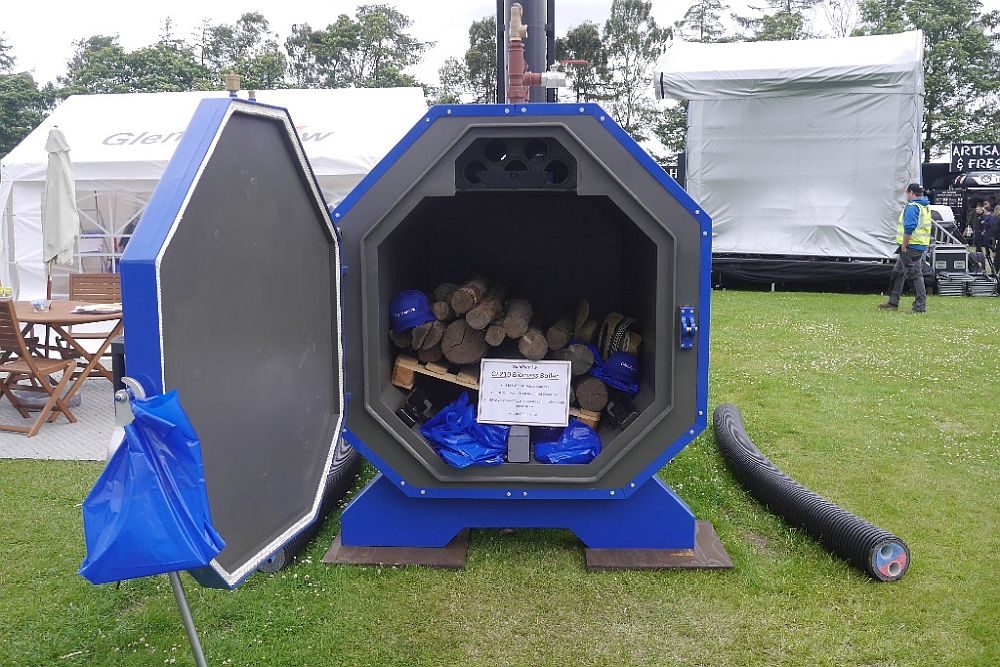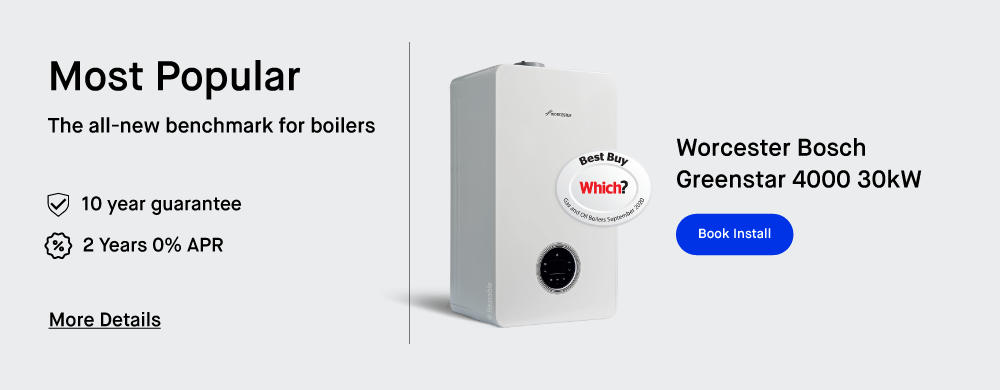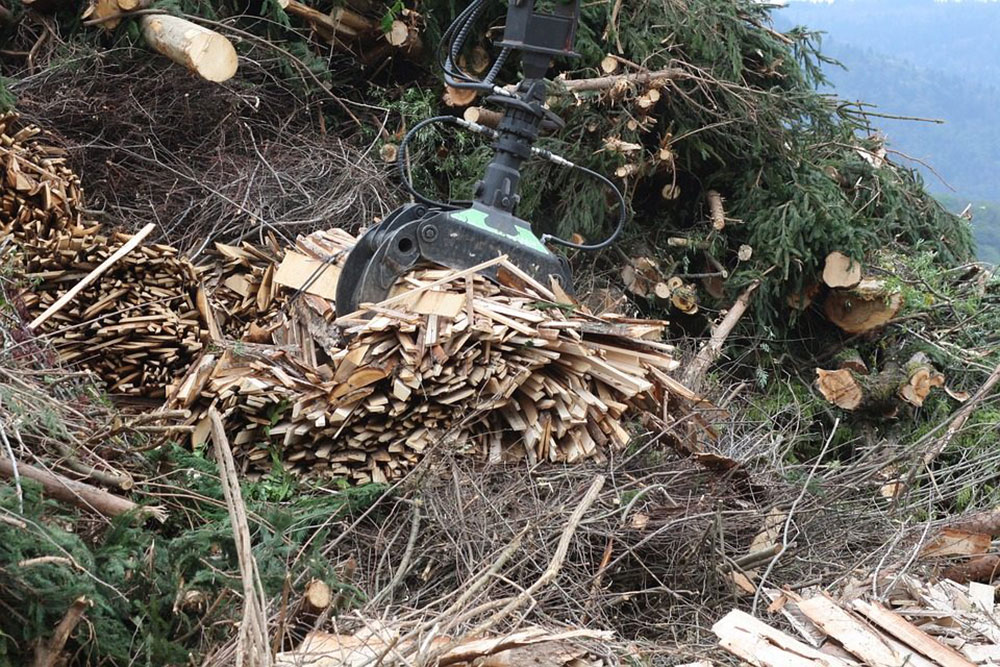What Is a Biomass Boiler, and How Much Does it Cost to Heat Your Home?
What exactly is a biomass boiler, and why should you care?
Well, as the UK barrels toward a net-zero future and fossil-fuels are nearing extinction, biomass boilers offer a green, inexpensive way to stay warm. In this post, we will cover everything you need to know about biomass boilers. You’ll learn how they work, how much they cost to buy and run, and how they compare to the more traditional gas- and oil-fired heating methods.

What Is a Biomass Boiler?
A domestic biomass boiler works much like its gas- or oil-fired peers, except they burn organic materials to create heat. They are an eco-friendly and efficient way to generate heat and supply hot water to a home’s taps. Moreover, with the 2025 gas boiler ban looming on the horizon, they’re a smart way to future proof your home heating system.
How Does Biomass Energy Work to Heat Your Home?
Like any fossil fuel boiler, a biomass boiler relies on combustion to give off heat. Here’s how the process works:
- Biomass fuel is fed into the boiler’s combustion chamber, either through an automated, semi-automated, or manual hopper;
- The fuel ignites and burns;
- The resulting hot gases are forced through a flue until they end up in a heat exchanger;
- Here, they heat water that circulates the building’s central heating system and the domestic hot water system;
- Any excess heat can get stored in a thermal tank (aka buffer tank), where the water keeps its high temperatures for days.
However, the key difference is that burning biomass makes for a green boiler, since the combustion process is carbon neutral. How, you may ask? Wood pellet suppliers, for example, tend to source their fuel from sustainably grown trees. And when you burn the biomass, you’re only releasing carbon which was caught in the first place by these trees. The net power consumption is dramatically lessened when compared to extracting oil out of the ground or burning coal for electrical systems.
Biomass Boiler Costs for Purchase and Installation
The quick answer — it depends, but you’re looking at spending anywhere between £5,000 and £15,000.
The long answer is more complex, but we will start with some pleasant news: you should be able to integrate your new biomass boiler into your building’s existing central heating and hot water systems. That means you shouldn’t have to replace your current network of pipes. Whew!
Now, the reality check: you will need space and lots of it. Unlike gas boilers, which get their supply from city pipes, your biomass boiler will need a large on-site fuel storage area.
Aside from this requirement, you’ll need enough room to fit the boiler’s hopper, which can range in size depending on its level of automation and fuel capacity.
With so many variables in the installation process, it’s hard to zero in on costs. However, we can give you an idea of what you’ll pay for the unit itself. Once again, the cost will vary between brands, and depend on the level of automation and power output. For example, a hand-fed, log-fired unit goes for about £5,000, while a fully automated, high-efficiency wood-pellet boiler can set you back upwards of £13,000.
How Do Biomass Boiler Prices Compare to Gas and Oil Boilers?
In contrast, traditional gas and oil boilers typically cost a fraction of this. Even a top-tier Worcester Bosch combi unit starts in the low £2,000s — just check out Heatable’s deals. You can also get them installed with an incredible 10-year warranty and flexible financing options.

Keep in mind that a biomass boiler needs a special flue. If your home is equipped with a chimney, you can get away with some simple modifications, such as lining the chimney with concrete or clay, or installing a flexible pipe, to turn it into a suitable flue.
If you don’t have a chimney, then a rigid flue can be installed through your building’s exterior wall. Note that fitting a flue for your biomass boiler is not an optional step! If you choose to forgo this process, you will create a fire hazard, let toxic gases get into your living areas, and risk damage to the chimney.
With the up-front costs seemingly steep, you may wonder if biomass boilers offer any financial advantage at all. They do, which brings me to the next point: operating costs.
How Much Does a Biomass Boiler Cost to Operate?
How much it costs you to run a biomass boiler will largely depend on the type of biomass products you’re using for fuel. Sure, factors like size and model also matter; but given the spread between the price of different biomass fuels, these variables are far less essential.
First, let’s have a look at how various biomass fuels compare in price per weight, average annual running costs, and contrast these with oil and gas.
Biomass Fuel Sources Explained
A biomass heating system has a natural fuel source — various byproducts of wood. Here below we look at the most common types of biomass fuel:
Wood Pellets
The most expensive biofuel, wood pellets command a premium for good reason: unlike chips and logs, their production process is lengthier and more involved. Expect to pay at least £250 per tonne of wood pellets. Heating with wood pellet boilers on an annual basis costs around £625.
Wood Chips
Chips are more economical than pellets and cost about £100 per tonne. They are less efficient than pellets, but your annual heating bill would still add up to only £340 because they’re that much cheaper per unit. That said, keep in mind that wood chips require a bit more work during refuelling; if you don’t mind the extra labour, wood chip boilers are the more economical option.
Logs
If you own woodland in a rural area, you may be able to grow your own trees for fuel and use a log boiler. You may need a felling license, and you’ll want a wood chipper or a log splitter to turn wood into an acceptable fuel.
If you’re not able or willing to cut trees for fuel, large chunks of rural land will still be handy. Storing a year’s supply of logs is way more practical than making several purchases and paying more for delivery.

If these savings strategies aren’t feasible, expect to pay about £100 per tonne of logs. As they pack approximately half the energy density of wood pellets, and you’d need about 5 tonnes of logs per year to heat a mid-sized home. So, you’re looking at £500 in heating costs. And don’t forget the labour needed to chop, store, and feed the logs into the boiler.
Biomass Boiler Heating Costs Compared to Oil and Gas
Heating with oil will cost you in the neighbourhood of £700 every year. With natural gas, you’re looking at an average annual bill of £600. If you factor in the higher supply and install costs of biomass boilers, the £100-150 annual savings don’t seem like much.
Enter the Renewable Heat Incentive (RHI) — a sort of biomass boiler grant, if you will. This government scheme, aimed at promoting renewable heat sources, may help put some money back into your pocket. Since biomass boilers run on renewable fuel, you may qualify for RHI payments if you swap your gas or oil boiler for an approved biomass system.
If you’re found eligible, the UK government will reimburse you for every kW your biomass boiler generates. While many variables go into the reimbursement calculation, the median amount is around 2.85p/kWh; with the average UK household using 12,000 kWh, the annual repayment comes to £342. Upon enrollment, the RHI program will make quarterly payments into your bank account for 7 years, provided that you stick to your side of the deal. Just keep in mind that the last day to enrol is 31 March 2022.
For your reference, here’s a quick comparison of the fuel prices, kWh per unit of fuel, and average heating costs, for biomass and fossil fuels:
| Fuel Type | Cost of Fuel | kWh/unit of fuel | p/kWh | Average Annual Costs |
| Wood Pellets | ~ £250 / tonne | 4,800kWh/tonne | 5.2p/kWh | £625 |
| Wood Chips | ~ £100 / tonne | 3,500kWh/tonne | 2.8p/kWh | £343 |
| Logs | ~ £100 / tonne | 2,400kWh/tonne | 4.2p/kWh | £500 |
| Natural Gas | n/a | 10kWh/m3 | 4.8p/kWh | £576 |
| Oil | n/a | 10kWh/litre | 6p/kWh | £720 |
| Electricity | n/a | 1kWh/kW | 13.5p/kWh | £1,620 |
How Are Fuels Supplied to Biomass Boilers?
You have 3 options for supplying the fuel into the boiler’s combustion chamber: automated and semi-automated hoppers, as well as manual (hand-fed) supply.
Automated Hopper
An automated hopper is the most convenient for fuelling your biomass boiler. This mechanism can store a large number of wood chips or pellets, which it feeds into the combustion chamber at set intervals. While it’s a handy solution that needs minimal input on your part, it does take up a sizeable chunk of space – which you should take into account before committing to your purchase.
Semi-automated Hopper
Also known as “surge bins”, these systems work much like automated ones, albeit with a bit more human input. That’s because their hoppers are smaller and need more frequent re-filling. While that translates into more work, these systems are more efficient and cost less. Their other benefit is their compact size, which makes a semi-automated boiler ideal for domestic use where space may be limited.
Manual Systems
Typically fuelled by logs, these are the cheapest biomass boilers on the market. They require frequent attention, as the operator has to hand-feed the wood logs into the filling chamber. That said, these manual systems take up way less space, and can prove quite efficient when paired with a quality thermal storage tank.
Regardless of how the boiler is fuelled, you will need to figure out where, and how you store the fuel. Even automated hoppers need refuelling, so you want to keep the source reasonably close to the boiler.
What Size Biomass Boiler Do I Need?
When we talk about boiler size, we mean its output, either in kWs or BTUs.
You should choose your biomass boiler size based on the expected heating demand. Trust a licensed heating engineer to figure this out. These professionals will account for certain key factors that a layman is likely to omit. As a norm, they will factor in the following:
- building type, dimensions, and total external wall area
- heat loss through walls, windows, floors, roof, and ventilation
- geographic location
- quantity of radiators
- whether it’s a regular boiler or a combi
- water flow rate
That’s not to say you can’t get a rough idea of your system’s size. Check out our Boiler Size Guide. Their guide may be for fossil-fuel boilers, but the optimal kW output is based on the number of rooms, the efficiency of insulation, and whether the boiler also heats your tap water. But don’t forget: this is just an estimate, and only a qualified heating engineer can establish the right boiler size.
Additional Factors to Consider Before Purchasing a Biomass Boiler
1. Boiler Dimensions
While “boiler size” typically means “power output,” with biomass boilers, physical dimensions matter big time. As I’ve mentioned before, biomass heating systems tend to be larger than their gas-fired peers. For instance, Worcester Bosch’s 24 kW Greenstar 30i measures just 710 x 400 x 330; meanwhile, Grant UK’s 26kW Grant Spira, a pellet-fired biomass unit, is double the height, almost triple the width, and quadruple the depth at 1535 x 1029 x 1120.
The impressive breadth stems from these boilers’ reliance on a hopper to feed them fuel. So, before you set your mind to buying one of these machines, make sure your home has sufficient space. And don’t forget, you’ll also need plenty of room for the biomass fuel store, which should ideally be somewhere close to the boiler.
2. Heating System
Are you just swapping your gas- or oil-fired boiler for a green biomass boiler? Then you should have no problems plugging your new machine into the existing network of pipes and radiators.
On the other hand, if yours is one of the rare buildings with forced air, you’ll need to install pipes and fit in a new wet central heat system.
3. Boiler Maintenance
Biomass boilers require a bit more maintenance than those that run on gas and oil.
For one, you’ll have to clear out ash. How often you do this depends on the boiler’s capacity and the intensity of operations. Still, you can expect to undertake this chore at least once a month.
As well, you’ll need to clean the flue and the heat exchanger to ensure they don’t get clogged up with soot. Now and then, you’ll also need to inspect the feed system for blockage with chips or pellets; and while you’re at it, be sure to oil the system’s bearings.
Once a year, you should have your biomass boiler inspected by a qualified technician. This professional will replace damaged parts, perform a deep clean of the system, and oil all the moving parts. Thus, long-term expenses should factor into your calculations for total new boiler cost.
Please note that before you proceed with any maintenance activities, your boiler should be shut off and have sufficient time to cool off.
4. Building Regulations and Planning Approval
Your new biomass boiler will need Building Regulations approval. It’s up to you to make sure that your project is up to current codes before applying for a permit.
Planning officials may also want to know about your project, specifically if it alters the visual appearance of the building or the roofline (which may happen if you install a new flue). On the other hand, if the process won’t affect aesthetics, you may be off the hook with Planning.
It always pays to check with your city officials before installing a renewable energy device.
Do Biomass Boilers Leave a Large Carbon Footprint?
Of all wet heating systems on the market, biomass boiler systems are arguably the greenest. Even compared to the relatively clean gas boilers, they give off only a fraction of the CO2.
Consider this: each natural gas boiler is responsible for roughly 6,404 kg of CO2 emissions annually. Their wood pellet-fired peers, on the other hand, emit only 766kg of CO2 per year, and wood chip-fired boilers discharge even less – only 550kg. That’s just one-tenth of a gas-fire boiler’s carbon footprint!
To get a better insight, check out how much CO2 these other fuels emit while powering a boiler:
- LPG – 7,663 kg
- oil – 9,219 kg
- coal – 13,541 kg
What kind of fuel does your boiler use?
Fixed price online with next day installation
As you can see, none of the existing wet heat systems can compete with biomass boilers when it comes to CO2 emissions.
Apart from being cleaner, biomass boilers also help divert millions of tonnes of wood from our landfills. How? By creating a demand for waste wood, which so easily turns into chips and pellets.
Are Biomass Boilers Worth It?
Yes — if you have the room to accommodate them and their fuel.
Let’s face it, the UK is fuel-poor. As of 2018, roughly 15% of all households lived in fuel poverty – a condition with varied definitions across different parts of the UK, but one that’s felt equally by millions of people. The future, too, looks bleak: with the proposed gas boiler ban swiftly approaching in 2025, we may soon heat with electricity at 14p/kWh.
That’s partly why we’re talking about these large, wood-burning machines: they may be worth your money in time to come. And while we leave that for you to decide, let’s review the pros and cons of biomass boilers before we wrap up.
What Are the Pros of Biomass Boilers?
- Biomass boilers offer a cheaper means of producing heat than their oil, coal, and electric equivalents. For now, the average annual costs are on par with those of gas heating. That said, with fossil fuels facing an uncertain path, biomass boilers may well become the cheapest option in the future.
- Biomass boilers give off just a tenth of the carbon emissions of a gas-fired unit. Their fuel source is renewable, and broadly speaking carbon-neutral.
- Biomass boilers owners qualify for the RHI programme, which offers a substantial quarterly subsidy that lasts for 7 years from enrollment.
- Biomass boilers come with various grades of automation, and corresponding levels of control over how much fuel you use.
What Are the Cons of Biomass Boilers?
- Biomass boilers are not cheap. Depending on their size and automation, they can command a price of over £13,000, while a top-tier gas-fired unit shouldn’t set you back more than £2,500.
- Biomass boilers require a special flue. If you have an existing chimney, it may be easy enough to upgrade; otherwise, you should expect to pay a bit more, and possibly get planning approval if the flue affects your building’s roofline.
- Even with a fully automated unit, biomass boilers will need you to refill their hopper with the fuel source. While you may not have to do this often, remember: biomass boilers are not a “get it and forget it” kind of machine.
- This type of boiler will require maintenance. You’ll have to clear ash and soot, oil the feeder’s bearings, and make sure that the wood chips or pellets don’t get clogged up.
- Biomass boilers need a lot of space. The boiler itself is typically at least double, or triple the size of a gas unit of similar kW output. And then there’s the fuel: those pellets, chips and logs don’t come out of a pipe like gas, and you’ll have to store them somewhere.
If you don’t feel that a biomass boiler is a worthy investment, keep in mind that gas is still a cheap and relatively clean source of heating fuel.
Biomass Boiler Cost: The Bottom Line
If you’re looking for a cheaper means of heating your home while emitting less carbon dioxide, then biomass boilers may be worth your money. This is notably true if you’re planning a new construction project after 2025, when gas-fired boilers may no longer be permitted in new-built homes.
That said, you should be ready to spend up to 5 times more on your biomass boiler than you would on its gas-fired peer. And while there are certain schemes to help you offset the impact of these initial costs, they are quickly running out, and you may be out of options by 2022.
You should also take into account the added effort needed to operate and maintain these boilers, not to mention the extra space you’ll need to house these units and their fuel.
Have any questions remaining about how biomass boilers work, or what they cost? Do you have any direct experience using a biomass boiler? Leave us a comment below!
